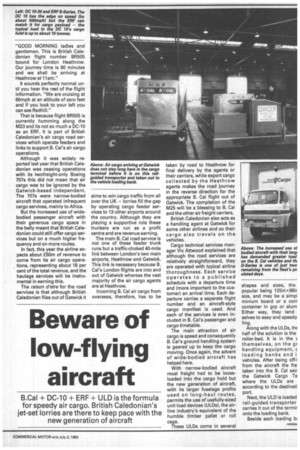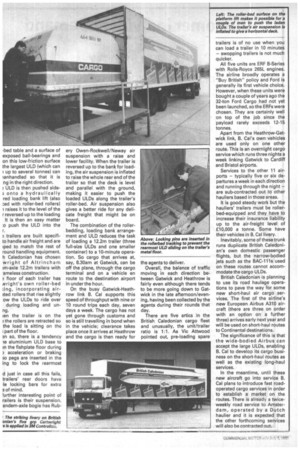Beware of low-flying aircraft
Page 55

Page 56

If you've noticed an error in this article please click here to report it so we can fix it.
B.Cal + DC-10 + ERF + ULD is the formula for speedy air cargo. British Caledonian's jet-set lorries are there to keep pace with the new generation of aircraft
"GOOD MORNING ladies and gentlemen. This is British Caledonian flight number BR505 bound for London Heathrow. Our journey time is 90 minutes and we shall be arriving at Heathrow at 11am."
It sounds perfectly normal until you hear the rest of the flight information. "We are cruising at 60mph at an altitude of zero feet and if you look to your left you can see Redhill."
That is because flight 8R505 is currently humming along the M23 and its not so much a DC-10 as an ERF. It is part of British Caledonian's air cargo road services which operate feeders and links to support B. Cal's air cargo operations.
Although it was widely reported last year that British Caledonian was ceasing operations with its twofreight-only Boeing 707s this did not mean that air cargo was to be ignored by the Gatwick-based independent. The 707s were narrow-bodied aircraft that operated infrequent cargo services, mainly to Africa.
But the increased use of widebodied passenger aircraft with their generous cargo space in the belly meant that British Caledonian could still offer cargo services but on a much higher frequency and on more routes.
In fact, this year the airline expects about £50m of revenue to come from its air cargo operations, representing about 18 per cent of the total revenue, and the haulage services will be instrumental in earning this.
The raison d'etre for the road services is that although British Caledonian flies out of Gatwick it aims to win cargo traffic from all over the UK — lorries fill the gap by operating cargo feeder services to 13 other airports around the country. Although they are playing a supportive role these trunkers are run as a profit centre and are revenue earning.
The main B. Cal road service is not one of these feeder trunk runs but a traffic-choked 40-mile link between London's two main airports, Heathrow and Gatwick. This link is necessary because B. Cal's London flights are into and out of Gatwick whereas the vast majority of the air cargo agents are at Heathrow.
Incoming B. Cal air cargo from overseas, therefore, has to be taken by road to Heathrow for final delivery by the agents or their carriers, while export cargo collected by the Heathrow agents makes the road journey in the reverse direction for the appropriate B. Cal flight out of Gatwick. The completion of the M25 will be a blessing to B. Cal and the other air freight carriers.
British Caledonian also acts as a handling agent at Gatwick for some other airlines and so their cargo also travels on the vehicles.
Cargo technical services manager Vic Attwood explained that although the road services are relatively straightforward, they are operated with typical airline thoroughness. Each service operates to a published schedule with a departure time and (more important to the customer) an arrival time. Each departure carries a separate flight number and an aircraft-style cargo manifest is used. And each of the services is even included in B. Cal's passenger and cargo timetable.
The main attraction of air cargo is speed and consequently B. Cal's ground handling system is geared up to keep the cargo moving. Once again, the advent of wide-bodied aircraft has helped here.
With narrow-bodied aircraft most freight had to be looseloaded into the cargo hold but the new generation of aircraft, with its larger fuselage profile used on long-haul routes, permits the use of usefully-sized unit load devices (ULDs), the airline industry's equivalent of the humble timber pallet or roll cage. These ULDs come in several shapes and sizes, the popular being 125inx88ir size, and may be a simpl minium board or a coni container in grp or alum Either way, they lend selves to easy and speedy ling.
Along with the ULDs, th( half of the solution is the roller-bed. It is in the themselves, on the gr handling equipment, c loading banks and i vehicles. After being off-I from the aircraft the fre taken into the B. Cal sec, the Gatwick Cargo Te where the ULDs are according to the destinati port.
Next, the ULD is loaded rail-guided transporter carries it out of the termir onto the loading bank.
Beside each loading br
-bed table and a surface of exposed ball-bearings and on this low-friction surface the largest ULD (which can up to several tonnes) can ianhandled so that it is ng in the right direction. ULD is then pushed side3 onto a hydraulically red loading bank lift (also .3ed with roller-bed rollers) raises it to the level of the r reversed up to the loading It is then an easy matter :o push the ULD into the r.
3 trailers are built specifito handle air freight and are ipod to match the rest of round handling equipment. h Caledonian has chosen wright of Altrincham 3m-axle 12.2m trailers with ameless construction.
3 floor of each trailer has Nright's own roller-bed :ing, incorporating airited rollers that rise slightly ow the ULDs to ride over during loading and unng.
len the trailer is on the 3 the rollers are retracted so the load is sitting on thc : part of the floor.
?,n so, there is a tendency le aluminium ULD base to m the fishplate floor during ) acceleration or braking 3o pegs are inserted in the ing to lock the rearmost
d just in case all this fails, trailers' rear doors have le locking bars for extra e of mind.
'urther interesting point of railers is their suspension. andem-axle bogie has Rub ery Owen-Rockwell/Neway air suspension with a raise and lower facility. When the trailer is reversed up to the bank for loading, the air suspension is inflated to raise the whole rear end of the trailer so that the deck is level and parallel with the ground, making it easier to push the loaded ULDs along the trailer's roller-bed. Air suspension also gives a better ride for any delicate freight that might be on board.
The combination of the rollerbedding, loading bank arrangement and ULD reduces the task of loading a 12.2m trailer (three full-size ULDs and one smaller container) to a 10-minute operation. So cargo that arrives at, say, 8.30am at Gatwick, can be off the plane, through the cargo terminal and on a vehicle en route to the destination airport in under the hour.
On the busy Gatwick-Heathrow link B. Cal supports this speed of throughput with nine or 10 round trips each day, seven days a week. The cargo has not yet gone through customs and so is still travelling in bond when in the vehicle; clearance takes place once it arrives at Heathrow and the cargo is then ready for the agents to deliver.
Overall, the balance of traffic moving in each direction between Gatwick and Heathrow is fairly even although there tends to be more going down to Gatwick in the late afternoon/evening, having been collected by the agents during their rounds that day.
There are five artics in the British Caledonian cargo fleet and unusually, the unit/trailer ratio is 1:1. As Vic Attwood pointed out, pre-loading spare trailers is of no use when you can load a trailer in 10 minutes — swopping trailers is not much quicker.
All five units are ERF B-Series with Rolls-Royce 265L engines. The airline broadly operates a "Buy British" policy and Ford is generally its first vehicle choice. However, when these units were bought a couple of years ago the 32-ton Ford Cargo had not yet been launched, so the ERFs were chosen. They are certainly well on top of the job since the payload rarely exceeds 12-15 tonnes.
Apart from the Heathrow-Gatwick link, B. Cal's own vehicles are used only on one other route. This is an overnight cargo service which runs three nights a week linking Gatwick to Cardiff and Bristol airports.
Services to the other 11 airports — typically five or six departures a week in each direction and running through the night — are sub-contracted out to other hauliers based in those areas.
It is good steady work but the hauliers' trailers must be rollerbed-equipped and they have to increase their insurance liability up to the air-freight level of £10,000 a tonne. Some have their vehicles in B. Cal livery.
Inevitably, some of these trunk runs duplicate British Caledonian's own domestic passenger flights, but the narrow-bodied jets such as the BAC-111s used on these routes cannot accommodate the cargo ULDs.
British Caledonian is planning to use its road haulage operations to pave the way for some new short-haul air cargo services. The first of the airline's new European Airbus A310 aircraft (there are three on order with an option on a further three) arrives early next year and will be used on short-haul routes to Continental destinations.
The significance of this is that the wide-bodied Airbus can accept the large ULDs, enabling B. Cal to develop its cargo business on the short-haul routes as well as the existing long-haul services.
In the meantime, until these new aircraft go into service B. Cal plans to introduce fast roadoperated cargo services in order to establish a market on the routes. There is alreadv a twiceweekly road service to Amsterdam, operated by a Dutch haulier and it is expected that the other forthcoming services will also be contracted nut.




































































































